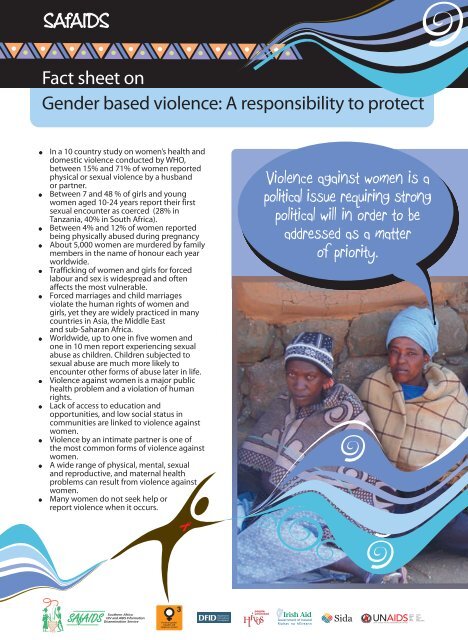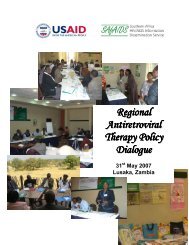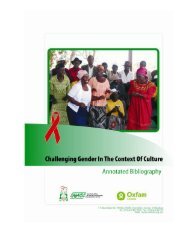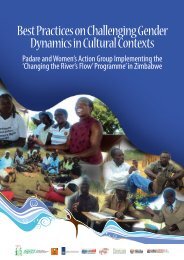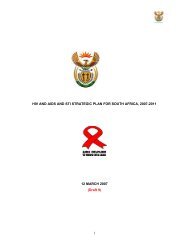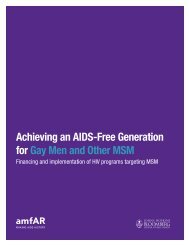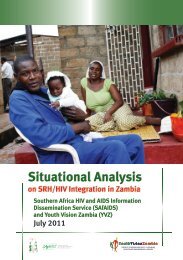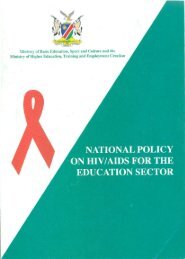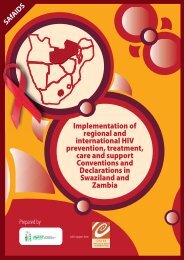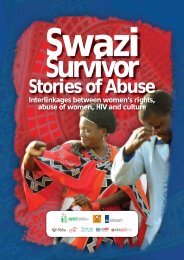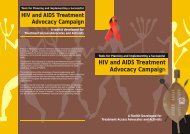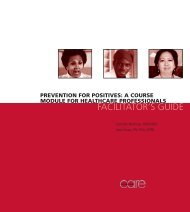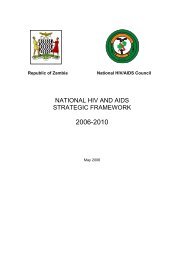Fact sheet on Gender based violence: A responsibility to ... - SAfAIDS
Fact sheet on Gender based violence: A responsibility to ... - SAfAIDS
Fact sheet on Gender based violence: A responsibility to ... - SAfAIDS
Create successful ePaper yourself
Turn your PDF publications into a flip-book with our unique Google optimized e-Paper software.
<str<strong>on</strong>g>Fact</str<strong>on</strong>g> <str<strong>on</strong>g>sheet</str<strong>on</strong>g> <strong>on</strong><br />
<strong>Gender</strong> <strong>based</strong> <strong>violence</strong>: A resp<strong>on</strong>sibility <strong>to</strong> protect<br />
In a 10 country study <strong>on</strong> women’s health and<br />
domestic <strong>violence</strong> c<strong>on</strong>ducted by WHO,<br />
between 15% and 71% of women reported<br />
physical or sexual <strong>violence</strong> by a husband<br />
or partner.<br />
Between 7 and 48 % of girls and young<br />
women aged 10-24 years report their first<br />
sexual encounter as coerced (28% in<br />
Tanzania, 40% in South Africa).<br />
Between 4% and 12% of women reported<br />
being physically abused during pregnancy<br />
About 5,000 women are murdered by family<br />
members in the name of h<strong>on</strong>our each year<br />
worldwide.<br />
Trafficking of women and girls for forced<br />
labour and sex is widespread and often<br />
affects the most vulnerable.<br />
Forced marriages and child marriages<br />
violate the human rights of women and<br />
girls, yet they are widely practiced in many<br />
countries in Asia, the Middle East<br />
and sub-Saharan Africa.<br />
Worldwide, up <strong>to</strong> <strong>on</strong>e in five women and<br />
<strong>on</strong>e in 10 men report experiencing sexual<br />
abuse as children. Children subjected <strong>to</strong><br />
sexual abuse are much more likely <strong>to</strong><br />
encounter other forms of abuse later in life.<br />
Violence against women is a major public<br />
health problem and a violati<strong>on</strong> of human<br />
rights.<br />
Lack of access <strong>to</strong> educati<strong>on</strong> and<br />
opportunities, and low social status in<br />
communities are linked <strong>to</strong> <strong>violence</strong> against<br />
women.<br />
Violence by an intimate partner is <strong>on</strong>e of<br />
the most comm<strong>on</strong> forms of <strong>violence</strong> against<br />
women.<br />
A wide range of physical, mental, sexual<br />
and reproductive, and maternal health<br />
problems can result from <strong>violence</strong> against<br />
women.<br />
Many women do not seek help or<br />
report <strong>violence</strong> when it occurs.<br />
Violence against women is a<br />
political issue requiring str<strong>on</strong>g<br />
political will in order <strong>to</strong> be<br />
addressed as a matter<br />
of priority.
ften treated as a marginal<br />
issue by governments GV<br />
is a global phenomen<strong>on</strong> and<br />
impacts people at all levels<br />
of society.<br />
What is gender <strong>based</strong> <strong>violence</strong> (GBV)?<br />
The United Nati<strong>on</strong>s defines gender <strong>based</strong><br />
<strong>violence</strong> as any act of <strong>violence</strong> that results in, or<br />
is likely <strong>to</strong> result in, physical, sexual or mental<br />
harm or suffering <strong>to</strong> men or women, including<br />
threats of such acts, coerci<strong>on</strong> or arbitrary<br />
deprivati<strong>on</strong> of liberty, whether occurring in public<br />
or in private life. Violence, the UN role is<br />
prep<strong>on</strong>derantly inflicted by men <strong>on</strong> women and<br />
girls.<br />
What forms does gender <strong>based</strong> <strong>violence</strong> take?<br />
There are many forms of <strong>violence</strong> against women,<br />
including:<br />
Sexual, physical, or emoti<strong>on</strong>al abuse by<br />
an intimate partner<br />
Physical or sexual abuse by family<br />
members or others<br />
Sexual harassment and abuse by<br />
authority figures (such as teachers, police<br />
officers or employers)<br />
Trafficking for forced labour or sex<br />
Harmful traditi<strong>on</strong>al practices such as as forced<br />
or child marriages and dowry-related <strong>violence</strong><br />
H<strong>on</strong>our killings, when women are<br />
murdered in the name of family h<strong>on</strong>our<br />
Systematic sexual abuse in c<strong>on</strong>flict<br />
situati<strong>on</strong>s is another form of <strong>violence</strong><br />
against women.<br />
What fac<strong>to</strong>rs fuel the GBV epidemic am<strong>on</strong>gst<br />
women and girls?<br />
There is a growing recogniti<strong>on</strong> that women and<br />
girls’ risk of, and vulnerability <strong>to</strong>, HIV infecti<strong>on</strong> is<br />
shaped by deep-rooted and pervasive gender<br />
inequalities and <strong>violence</strong> against them in<br />
particular. Women’s low status in society is the<br />
most striking underlying fac<strong>to</strong>r for gender <strong>based</strong><br />
<strong>violence</strong>. Other comm<strong>on</strong> underlying and<br />
situati<strong>on</strong>al fac<strong>to</strong>rs include:<br />
<strong>Gender</strong> inequality<br />
Social norms supportive of traditi<strong>on</strong>al<br />
gender roles and associating masculinity<br />
with <strong>violence</strong><br />
Poverty, ec<strong>on</strong>omic stress and<br />
unemployment<br />
Weak community sancti<strong>on</strong>s<br />
Lack of instituti<strong>on</strong>al support from police<br />
and judicial systems<br />
Where there are restrictive laws <strong>on</strong><br />
divorce and ownership and inheritance<br />
of property<br />
Alcohol and substance misuse<br />
Dysfuncti<strong>on</strong>al, unhealthy relati<strong>on</strong>ships<br />
characterised by inequality, power<br />
imbalances and c<strong>on</strong>flict<br />
Where there is social breakdown due <strong>to</strong><br />
c<strong>on</strong>flicts or disasters<br />
Why should policy makers address GBV?<br />
The single greatest threat <strong>to</strong> the expansi<strong>on</strong> of<br />
human capabilities in the southern Africa regi<strong>on</strong><br />
<strong>to</strong>day remains the HIV epidemic, is undermining<br />
human development objectives and thereby<br />
reversing the positive effects of nati<strong>on</strong>al and<br />
regi<strong>on</strong>al development. Sexual <strong>violence</strong> directly<br />
and indirectly increases the vulnerability of<br />
women and girls <strong>to</strong> HIV infecti<strong>on</strong>. Ending sexual<br />
<strong>violence</strong> is <strong>on</strong>e vital step in efforts <strong>to</strong> s<strong>to</strong>p the<br />
spread of HIV. <strong>Gender</strong> <strong>based</strong> <strong>violence</strong> is<br />
increasingly becoming an urgent public health<br />
and human rights problem particularly in the<br />
c<strong>on</strong>text of HIV. Evidence from the sub-regi<strong>on</strong> is<br />
dem<strong>on</strong>strating that <strong>violence</strong> against women has<br />
reached epidemic levels thereby perpetuating<br />
women and girls’ vulnerability and susceptibility<br />
<strong>to</strong> HIV infecti<strong>on</strong>:<br />
In sub-Saharan Africa, young women (15-24<br />
years) account for 75 % of HIV infecti<strong>on</strong>s and<br />
are approximately three times more likely <strong>to</strong><br />
be infected than young men of the same age.<br />
Studies from Rwanda, Tanzania, and South<br />
Africa show up <strong>to</strong> three-fold increases in risk<br />
of c<strong>on</strong>tracting HIV am<strong>on</strong>g women who have<br />
experienced <strong>violence</strong> compared <strong>to</strong> those who<br />
have not.<br />
Women and girls c<strong>on</strong>tinue <strong>to</strong> be<br />
disproporti<strong>on</strong>ally affected by HIV in<br />
sub-Saharan Africa. Throughout the regi<strong>on</strong>,<br />
women account for 60% of all HIV infecti<strong>on</strong>s.<br />
Violence and fear of <strong>violence</strong> makes it difficult<br />
for women <strong>to</strong> negotiate for safer sex, including<br />
c<strong>on</strong>dom use with their sexual partners.<br />
Fear of <strong>violence</strong> prevents women from<br />
accessing HIV preventi<strong>on</strong>, treatment, care and<br />
support services.<br />
90,000 children were newly infected with<br />
$IV in 2008. More than 90% of HIV infecti<strong>on</strong>s<br />
in infants and children are passed <strong>on</strong> by<br />
mothers during pregnancy, labour, delivery<br />
or breastfeeding. Without preventing new HIV<br />
infecti<strong>on</strong>, the regi<strong>on</strong> will not manage <strong>to</strong> meet<br />
the majority of the Millennium Development<br />
Goals (MDGs).<br />
Sub Saharan Africa recorded 1)9 milli<strong>on</strong> new<br />
$IV infecti<strong>on</strong>s in 2008 al<strong>on</strong>e)
<strong>Gender</strong> <strong>based</strong> <strong>violence</strong> is an<br />
abuse of human rights and<br />
failure <strong>to</strong> address it amounts<br />
<strong>to</strong> complicity. The cost of not<br />
addressing gender <strong>based</strong><br />
<strong>violence</strong> is significant both<br />
socially and ec<strong>on</strong>omically.<br />
What are the internati<strong>on</strong>al and regi<strong>on</strong>al policy<br />
instruments that policy makers can refer <strong>to</strong><br />
when taking acti<strong>on</strong> <strong>to</strong> make a difference?<br />
Significant steps have been taken by leaders at<br />
global, regi<strong>on</strong>al and country level <strong>to</strong> improve the<br />
legal and policy envir<strong>on</strong>ment <strong>to</strong> prevent and<br />
resp<strong>on</strong>d <strong>to</strong> gender <strong>based</strong> <strong>violence</strong>. Although the<br />
existence of such instruments cannot bring about<br />
the fundamental changes necessary <strong>to</strong> combat<br />
gender <strong>based</strong> <strong>violence</strong>, they however pave the<br />
way for c<strong>on</strong>crete acti<strong>on</strong> at nati<strong>on</strong>al level that can<br />
influence local resp<strong>on</strong>ses. It is important for policy<br />
makers and in particular parliamentarians due <strong>to</strong><br />
their oversight role, <strong>to</strong> understand the laws and<br />
policies pertaining <strong>to</strong> combating GBV. In additi<strong>on</strong><br />
parliamentarians must be c<strong>on</strong>versant with the<br />
enforcement mechanisms of such legal and policy<br />
instruments.<br />
1994 Internati<strong>on</strong>al C<strong>on</strong>ference <strong>on</strong><br />
Populati<strong>on</strong> and Development<br />
(ICPD-Cairo)<br />
The programme of Acti<strong>on</strong> affirms that women’s<br />
rights are an integral part of all human rights.<br />
Women’s empowerment is recognised as central<br />
<strong>to</strong> politics, government and other professi<strong>on</strong>s and<br />
pers<strong>on</strong>al relati<strong>on</strong>ships. It makes recommendati<strong>on</strong>s<br />
for acti<strong>on</strong>s by governments including prohibiting<br />
the trafficking of children and women, protecting<br />
women from <strong>violence</strong> through educati<strong>on</strong> and<br />
establishing measures and rehabilitati<strong>on</strong><br />
programmes for survivors of <strong>violence</strong>. The ICPD<br />
was the first internati<strong>on</strong>al forum <strong>to</strong> acknowledge<br />
the enjoyment of sexual health as an integral part<br />
of reproductive rights.<br />
1979 United Nati<strong>on</strong>s C<strong>on</strong>venti<strong>on</strong> <strong>on</strong><br />
the Eliminati<strong>on</strong> of All Forms of<br />
Discriminati<strong>on</strong> Against Women<br />
(CEDAW),<br />
CEDAW elaborates <strong>on</strong> the significant roles states<br />
and private ac<strong>to</strong>rs must play in ending GBV. It<br />
guarantees women equal rights with men in all<br />
spheres of life, including educati<strong>on</strong>, employment,<br />
healthcare, voting, nati<strong>on</strong>ality and marriage. The<br />
Committee <strong>on</strong> the Eliminati<strong>on</strong> of All forms of<br />
Discriminati<strong>on</strong> Against Women was established <strong>to</strong><br />
review reports which all countries that are<br />
signa<strong>to</strong>ries <strong>to</strong> the c<strong>on</strong>venti<strong>on</strong> must submit <strong>on</strong><br />
women’s status.<br />
1995 Beijing Global Platform for<br />
Acti<strong>on</strong>-adopted at the 4 th World<br />
C<strong>on</strong>ference <strong>on</strong> Women<br />
The 1995 Beijing Platform for Acti<strong>on</strong> recognises<br />
that all governments, irrespective of their political,<br />
ec<strong>on</strong>omic and cultural systems are resp<strong>on</strong>sible for<br />
protecting and promoting women’s human rights.<br />
It has a broad <strong>based</strong> agenda for promoting and<br />
protecting women’s human rights and establishes<br />
the principle of shared power and resp<strong>on</strong>sibility<br />
between men and women. This document<br />
specifically identifies <strong>violence</strong> against women as<br />
<strong>on</strong>e of the 12 critical areas of c<strong>on</strong>cern and obstacle<br />
<strong>to</strong> the achievement of women’s human rights.<br />
2008 SADC Pro<strong>to</strong>col <strong>on</strong> <strong>Gender</strong> and<br />
Development<br />
The SADC Pro<strong>to</strong>col <strong>on</strong> <strong>Gender</strong> and Development<br />
encompasses commitments made in all regi<strong>on</strong>al,<br />
global and c<strong>on</strong>tinental instruments for achieving<br />
gender equality and enhances these instruments<br />
by addressing gaps and setting specific measurable<br />
targets where these do not already exist. The<br />
pro<strong>to</strong>col advances gender equality by ensuring<br />
accountability by all SADC Member States, as well<br />
as providing a forum for the sharing of best<br />
practices, peer support and review.<br />
Effective change requires a<br />
str<strong>on</strong>g instituti<strong>on</strong>al framework<br />
and nati<strong>on</strong>al bodies that have<br />
the power and the capacity <strong>to</strong><br />
take acti<strong>on</strong>.<br />
3
4<br />
What must policy makers do <strong>to</strong> curb the GBV<br />
epidemic in southern Africa?<br />
Policy makers have an important role in catalysing<br />
acti<strong>on</strong> <strong>to</strong> prevent and address GBV at nati<strong>on</strong>al level.<br />
Some key acti<strong>on</strong>s for policy makers include the<br />
following:<br />
Policy makers must raise the visibility of gender<br />
<strong>based</strong> <strong>violence</strong>, have access <strong>to</strong> accurate data,<br />
and know about <strong>violence</strong> against women.<br />
Policies must recognise that GBV increases HIV<br />
risk both directly and indirectly through,<br />
increasing high risk practices. Both GBV survivors<br />
and perpetra<strong>to</strong>rs are at high risk of c<strong>on</strong>tracting<br />
HIV. GBV is acti<strong>on</strong>able – the policy paradigm<br />
must address primary preventi<strong>on</strong> (s<strong>to</strong>pping the<br />
risk by reducing GBV), sec<strong>on</strong>dary preventi<strong>on</strong><br />
(taking steps <strong>to</strong> ensure that GBV does not lead<br />
<strong>to</strong> HIV) and tertiary preventi<strong>on</strong> (reducing the<br />
c<strong>on</strong>sequences of HIV).<br />
Advocate for enactment and implementati<strong>on</strong><br />
of laws that comprehensively address GBV in<br />
all its forms.<br />
Take leadership and spearhead policy review<br />
that clearly articulates the country’s positi<strong>on</strong> <strong>on</strong><br />
gender <strong>based</strong> <strong>violence</strong> and HIV preventi<strong>on</strong>. Key<br />
questi<strong>on</strong>s that should be addressed by such<br />
policies include the recogniti<strong>on</strong> of the role of<br />
GBV in increasing the HIV risk of victims and<br />
recogniti<strong>on</strong> of the special HIV risk and<br />
subsequent role of GBV.<br />
Policy makers must lead their countries in<br />
developing nati<strong>on</strong>al acti<strong>on</strong>s plans for <strong>violence</strong><br />
preventi<strong>on</strong> that prioritise preventi<strong>on</strong> of <strong>violence</strong><br />
against women.<br />
The highest political level possible should be<br />
mandated <strong>to</strong> coordinate a multi-sec<strong>to</strong>ral<br />
resp<strong>on</strong>se <strong>to</strong> gender-<strong>based</strong> <strong>violence</strong> at nati<strong>on</strong>al<br />
level. Such multi-sec<strong>to</strong>ral ac<strong>to</strong>rs include health<br />
and social services, religious organisati<strong>on</strong>s, the<br />
judiciary and police, trade uni<strong>on</strong>s and<br />
businesses, and the media.<br />
Integrate resp<strong>on</strong>ses <strong>to</strong> <strong>violence</strong> against women<br />
in existing programmes for the preventi<strong>on</strong> of<br />
HIV, and for the promoti<strong>on</strong> of adolescent health.<br />
References<br />
1. Inter-parliamentary Uni<strong>on</strong>,2009 , Parliaments<br />
Take acti<strong>on</strong> <strong>to</strong> <strong>on</strong> <strong>violence</strong> against women,<br />
Priority acti<strong>on</strong>s for parliaments<br />
2. Irish Joint C<strong>on</strong>sortium <strong>on</strong> GBV, 2007, Keeping<br />
<strong>Gender</strong> <strong>on</strong> the agenda: <strong>Gender</strong> <strong>based</strong><strong>violence</strong>,<br />
poverty and development, Issue paper<br />
3. UNICEF, 2009, Children and AIDS Fourth<br />
S<strong>to</strong>cktaking Report, 2009<br />
4. World Health Organisati<strong>on</strong>, 2005, WHO, Multicountry<br />
Study <strong>on</strong> Women’s Health and<br />
Domestic Violence against Women<br />
5. United Nati<strong>on</strong>s,1995, Beijing Declarati<strong>on</strong> and<br />
Platform for acti<strong>on</strong> 4th World C<strong>on</strong>ference <strong>on</strong><br />
Women<br />
6. UNFPA, 2008, UNFPA Strategy and Framework<br />
for Acti<strong>on</strong> <strong>to</strong> Addressing <strong>Gender</strong>-<strong>based</strong> Violence<br />
2008-2011 <strong>Gender</strong>, Human Rights and Culture<br />
Branch UNFPA Technical Divisi<strong>on</strong><br />
7. Populati<strong>on</strong> Council, 2008,Sexual and gender<br />
<strong>based</strong> <strong>violence</strong> in Africa, Literature Review<br />
UNAIDS and RHRU <strong>Gender</strong>-<strong>based</strong> <strong>violence</strong>,<br />
young women and girls, and HIV in southern<br />
Africa, Policy and Programme Acti<strong>on</strong> Brief<br />
<strong>SAfAIDS</strong> Regi<strong>on</strong>al Office: 479 Sappers C<strong>on</strong><strong>to</strong>ur, Lynnwood, Pre<strong>to</strong>ria 0081, South Africa<br />
Tel: +27 12 361 0889, Fax: +2712 361 0899, Email: info@safaids.net, Website: www.safaids.net


